水产养殖专业英语讲义
- 格式:pdf
- 大小:572.31 KB
- 文档页数:53

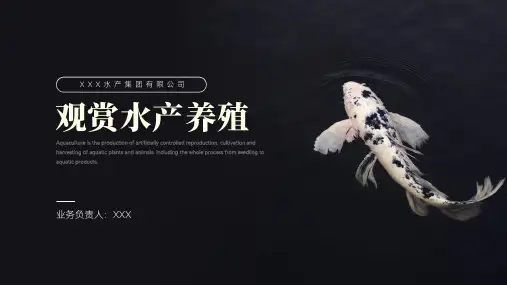

《水产养殖概论》一、课程基本信息课程编号:2512690课程中文名称:水产养殖概论课程英文名称:Fisheries Summary课程类型:学科选修课总学时:54 理论学时:18 实验学时:36 课外学时:0学分: 2适用专业:生物科学先修课程:动物学,植物学开课院系:生命科学学院二、课程性质和任务《水产养殖概论》为生物科学专业的一门选修课,其任务是介绍重要水产经济动植物的生物学特性、育种方法、繁育技术、苗种培育和养成技术,使学生掌握水产动植物的相关基础理论知识、技术和生产过程。
三、课程教学目标1.结合生物科学的学科特点,系统地讲解水产动植物的几种主要育种方法,使学生能够理解各种方法的操作原理并在相关的研究领域运用自如。
2.介绍主要水产动植物的一些生物学特性,使学生了解自然和养殖条件下动植物的习性(包括温度、光照、饵料、繁殖等)变化。
3.重点讲授各种经济水产动植物的繁育机理和苗种生产方法,使学生对苗种繁育过程的各项操作和硬件设施要求有所明晰。
四、理论教学环节和基本要求(一)绪论了解水产养殖业的发展与成就及我国水产养殖的自然资源条件。
掌握水产养殖的重要养殖品种。
(二)水产养殖动物育种了解国内外水产动物育种的进展。
掌握水产动物育种中选择、杂交的基本原理和方法,雌雄核发育、多倍体诱导、性别控制、细胞融合与核移植、转基因、种质资源保护的基本理论和应用技术。
(三)主要养殖鱼类的生物学与人工繁殖了解鱼类养殖的发展动态和政策法规。
掌握主要养殖鱼类的生物学、人工繁殖理论与技术、苗种培育和养成的理论和技术。
(四)经济甲壳类的繁殖与养殖了解虾蟹类增殖、活运、保鲜及加工的一般技术。
掌握甲壳动物的生物学特征,甲壳动物的分类知识。
另一方面重点掌握十足类经济虾蟹的基础生物学,虾蟹类育苗与养成的原理与通用技术,虾蟹类的增殖、活运与加工等技术。
(五)经济贝类的繁殖与养殖了解国内外贝类增养殖技术的发展趋势。
掌握养殖贝类的形态构造、生态习性,掌握贝类的苗种生产和增养殖方法。


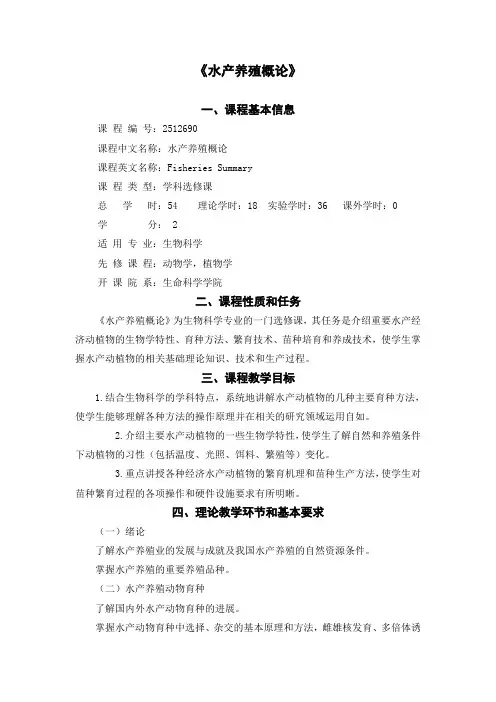
《水产养殖概论》一、课程基本信息课程编号:2512690课程中文名称:水产养殖概论课程英文名称:Fisheries Summary课程类型:学科选修课总学时:54 理论学时:18 实验学时:36 课外学时:0学分: 2适用专业:生物科学先修课程:动物学,植物学开课院系:生命科学学院二、课程性质和任务《水产养殖概论》为生物科学专业的一门选修课,其任务是介绍重要水产经济动植物的生物学特性、育种方法、繁育技术、苗种培育和养成技术,使学生掌握水产动植物的相关基础理论知识、技术和生产过程。
三、课程教学目标1.结合生物科学的学科特点,系统地讲解水产动植物的几种主要育种方法,使学生能够理解各种方法的操作原理并在相关的研究领域运用自如。
2.介绍主要水产动植物的一些生物学特性,使学生了解自然和养殖条件下动植物的习性(包括温度、光照、饵料、繁殖等)变化。
3.重点讲授各种经济水产动植物的繁育机理和苗种生产方法,使学生对苗种繁育过程的各项操作和硬件设施要求有所明晰。
四、理论教学环节和基本要求(一)绪论了解水产养殖业的发展与成就及我国水产养殖的自然资源条件。
掌握水产养殖的重要养殖品种。
(二)水产养殖动物育种了解国内外水产动物育种的进展。
掌握水产动物育种中选择、杂交的基本原理和方法,雌雄核发育、多倍体诱导、性别控制、细胞融合与核移植、转基因、种质资源保护的基本理论和应用技术。
(三)主要养殖鱼类的生物学与人工繁殖了解鱼类养殖的发展动态和政策法规。
掌握主要养殖鱼类的生物学、人工繁殖理论与技术、苗种培育和养成的理论和技术。
(四)经济甲壳类的繁殖与养殖了解虾蟹类增殖、活运、保鲜及加工的一般技术。
掌握甲壳动物的生物学特征,甲壳动物的分类知识。
另一方面重点掌握十足类经济虾蟹的基础生物学,虾蟹类育苗与养成的原理与通用技术,虾蟹类的增殖、活运与加工等技术。
(五)经济贝类的繁殖与养殖了解国内外贝类增养殖技术的发展趋势。
掌握养殖贝类的形态构造、生态习性,掌握贝类的苗种生产和增养殖方法。
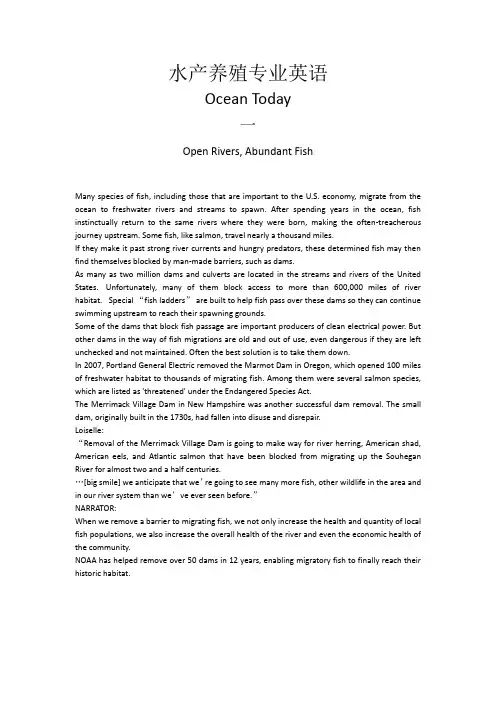
水产养殖专业英语Ocean Today一Open Rivers, Abundant FishMany species of fish, including those that are important to the U.S. economy, migrate from the ocean to freshwater rivers and streams to spawn. After spending years in the ocean, fish instinctually return to the same rivers where they were born, making the often-treacherous journey upstream. Some fish, like salmon, travel nearly a thousand miles.If they make it past strong river currents and hungry predators, these determined fish may then find themselves blocked by man-made barriers, such as dams.As many as two million dams and culverts are located in the streams and rivers of the United States.Unfortunately, many of them block access to more than 600,000 miles of river habitat.Special “fish ladders”are built to help fish pass over these dams so they can continue swimming upstream to reach their spawning grounds.Some of the dams that block fish passage are important producers of clean electrical power. But other dams in the way of fish migrations are old and out of use, even dangerous if they are left unchecked and not maintained. Often the best solution is to take them down.In 2007, Portland General Electric removed the Marmot Dam in Oregon, which opened 100 miles of freshwater habitat to thousands of migrating fish. Among them were several salmon species, which are listed as 'threatened' under the Endangered Species Act.The Merrimack Village Dam in New Hampshire was another successful dam removal. The small dam, originally built in the 1730s, had fallen into disuse and disrepair.Loiselle:“Removal of the Merrimack Village Dam is going to make way for river herring, American shad, American eels, and Atlantic salmon that have been blocked from migrating up the Souhegan River for almost two and a half centuries.…[big smile] we anticipate that we’re going to see many more fish, other wildlife in the area and in our river system than we’ve ever seen before.”NARRATOR:When we remove a barrier to migrating fish, we not only increase the health and quantity of local fish populations, we also increase the overall health of the river and even the economic health of the community.NOAA has helped remove over 50 dams in 12 years, enabling migratory fish to finally reach their historic habitat.二Fish on a FarmEvery weekend small farmers around the country head to their local farmer’s markets to selltheir fruits and veggies.Well guess what? There’s a new farmer in town. Fish farmers.In the U.S., we import over 80% of the seafood we eat, and half of that is farmed. This growing demand for safe, healthy seafood has prompted a revival of the fish farming industry here athome.Farmers raise finfish using a variety of methods, but they all start out with baby fish or fingerlings raised in a hatchery. Once they are large enough, the fish are placed in either surface pens near the shore or submersible cages in the open ocean. The netting or cages allow ocean water to flow in and out, but keeps the fish contained in one area.Fish food is dispensed from buoys floating on the surface at the top of the pen. Once the fish have matured –they are harvested using large vacuums. The fish are then prepped, placed on ice, and taken to market. There are some environmental concerns associated with fish farming: For example, the pellets used to feed the fish are actually made from small fish caught in the wild. In order to keep larger numbers of these important fish in the food chain, experts are now finding alternativeingredients for fishmeal.Another concern is that too many cages in the wrong location can lead to water pollution.But experts are now using computer models to map out sites where cages would have lessenvironmental impact.Fish farming can generate jobs and profits here at home.And with the use of new technologies, it can also safely and sustainably meet the demands of a seafood hungry nation.Seafood Does a Body GoodWhen we head to the beach we think of sun, sand, and fun.At the end of the day many of us like to enjoy fresh, local seafood. Even if you are not on the coast, seafood is becoming a number one treat for going out to eat. The good news is safe seafood does a body good. Seafood supplies protein, nutrients, and essential omega-3 fatty acids; protects against cardio-vascular disease; and benefits brain development. And seafood is good for the economy. In 2012, the U.S. commercial fishing industry generated $141 billion in sales, $39 billion in income, and supported 1.3 million jobs.Aquaculture, also known as fish and shellfish farming –is outpacing wild harvest fisheriesglobally in order to meet seafood demand.The US also has a vibrant and growing aquaculture industry.While the U.S. is a world leader in sustainability, with NOAA Fisheries managing and improving fish habitats and stocks, our marine scientists are at the cutting edge of research that’s keepingour seafood supply safe.For example, researchers are successfully developing and testing alternative feeds for farmed freshwater and marine fish to help maintain high nutritional value while reducing our reliance ona limited supply of fishmeal and fish oil in aquafeeds.And, scientists at NOAA’s Northwest Fisheries Science Center are testing the Environmental Sample Processor to help forecast blooms of harmful algae and bacteria up to a week in advance in order to protect shellfish beds and the public from possible exposure.The shellfish industry in the Pacific Northwest supplies millions of pounds of seafood to the U.S. and the world.And millions of dollars in funding opportunities through NOAA Sea Grant and the U.S.Department of Agriculture’s Small Business Innovation Research will help foster otheradvancements in aquaculture science and technology.These efforts across NOAA, other federal agencies, and their partners will continue to support a safe, healthy and secure seafood supply for us all to enjoy.Because seafood health, the ocean’s health, and our health, all rely on one another.North Atlantic Right WhalesThe North Atlantic right whale got its name from whalers. Because these whales travel slowly and spend a lot of time at the surface, they were easy targets.For whalers they were the “right”whales to hunt. With fewer than 400 left, they are now the “right”whales to save. Marine biologists track their migratory routes off North America for the spring and fall, but the wintering grounds for much of the right whale population are unknown. Using hydrophones, scientists recorded whale calls in the waters between Greenland and Iceland from July to December of 2007. A hydrophone is simply a microphone designed to capture underwatersounds.North Atlantic right whale calls sound like screams, bangs, and groans. After deciphering thousands of these new recordings, there was evidence of right whales calling nearby many times. This area was thought to be an abandoned habitat, but this discovery confirms that itcontinues to be used.New discoveries always lead to more questions: How many whales are there? Could these whales be members of a totally separate population, or even an eastern population thought to beextinct?Whatever the answers may be, hydrophones helped us find these whales in a hard to reach location. But most important, if we know where these right whales are wintering, then we can better protect them and maybe even help them recover.五Antarctic KrillKrill are small crustaceans found throughout the ocean. They play an important role in theaquatic food chain, particularly in the Southern Ocean.Antarctic krill provide a vital food source for whales, seals, ice fish, and penguins.These animals depend on eating large quantities of krill for survival in the harsh climate.For their own meals, Antarctic krill eat small plants like phytoplankton, as well as algae under thesurface of sea ice.Krill have the ability to shrink their bodies and undergo long periods of starvation.These adaptations allow them to survive the winter months in the Antarctic.Krill travel in swarms so dense they can actually be seen from space.And it’s estimated that the total weight of Antarctic krill is more than the weight of all humans on Earth.Pretty impressivefor an animal the size of your pinky.And that’s life with the ice for Antarctic krill.六Building Good MusselsFarmers grow all kinds of seafood such as fish, shrimp, and oysters. That may sound funny but it is a method called “aquaculture.”Aquaculture happens in ponds, rivers, bays, and the ocean. Farmers also grow a type of shellfish called “mussels.”You may have seen mussels growing from a pier, jetty, or dock. Their black shell is hard and, in the wild, they grow in clusters. Musselsare easy to farm and great to eat.They also help clean the water. Mussels are filter-feeders, which means that they feed by collecting tiny organisms from the water. So they clean and filter the water as they eat. Fishermen from Rhode Island to Maine are beginning to farm mussels in socks in the ocean. First, they collect baby mussel seed on ropes near the shore. The seed goes into a sock around a long rope. On the water, the sock with the rope is connected to buoys, dropped into the water, and left to grow in the ocean for at least a year. After one year, juicy mussels are bursting through the socks. They are collected, packed on ice, and brought back to shore to sell.A small farm with 12 long lines can produce up to 180,000 pounds of mussels each year. Farming mussels on rafts and on the bottom is hard work, muddy, and messy. But it can be fun, too. Right now, in the United States, mussel farming is catching on among fishermen and farmers. It’s helping provide the seafood we need in a healthy and sustainable manner.。
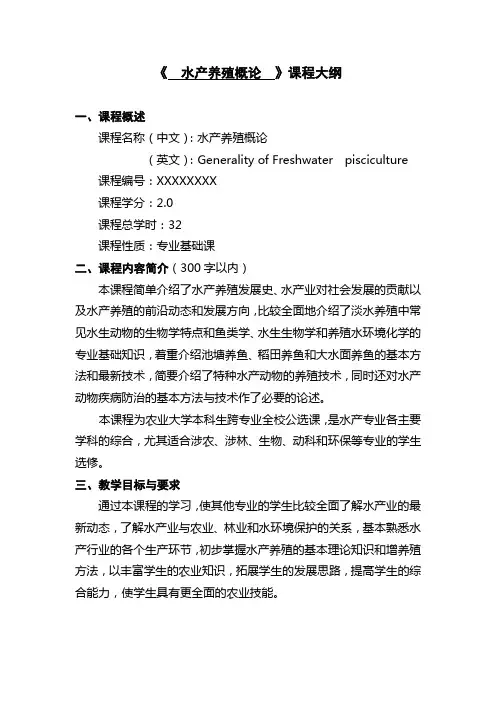
《水产养殖概论》课程大纲一、课程概述课程名称(中文):水产养殖概论(英文):Generality of Freshwater pisciculture 课程编号:XXXXXXXX课程学分:2.0课程总学时:32课程性质:专业基础课二、课程内容简介(300字以内)本课程简单介绍了水产养殖发展史、水产业对社会发展的贡献以及水产养殖的前沿动态和发展方向,比较全面地介绍了淡水养殖中常见水生动物的生物学特点和鱼类学、水生生物学和养殖水环境化学的专业基础知识,着重介绍池塘养鱼、稻田养鱼和大水面养鱼的基本方法和最新技术,简要介绍了特种水产动物的养殖技术,同时还对水产动物疾病防治的基本方法与技术作了必要的论述。
本课程为农业大学本科生跨专业全校公选课,是水产专业各主要学科的综合,尤其适合涉农、涉林、生物、动科和环保等专业的学生选修。
三、教学目标与要求通过本课程的学习,使其他专业的学生比较全面了解水产业的最新动态,了解水产业与农业、林业和水环境保护的关系,基本熟悉水产行业的各个生产环节,初步掌握水产养殖的基本理论知识和增养殖方法,以丰富学生的农业知识,拓展学生的发展思路,提高学生的综合能力,使学生具有更全面的农业技能。
四、教学内容与学时安排绪论(2.0学时)1. 教学目的与要求:要求学生明确水产养殖、水产养殖业和水产养殖学的的概念,认识学习本课程的目的和任务,了解水产养殖业的发展、成就及对社会的贡献,熟悉水产养殖业的前沿动态、发展潜力和未来方向。
2. 教学重点与难点:重点是水产养殖业的发展、成就及对社会的贡献。
难点是理解水产养殖、水产养殖业和水产养殖学的区别。
第一章鱼类基础知识(6.0学时)1. 教学目的与要求:要求学生了解鱼类的外部形态、内部结构,掌握鱼类主要器官及其机能、生态习性和主要生理特点,熟悉我国主要养殖的常见种类。
2. 教学重点与难点:重点是鱼类的生活习性、食性划分、和雌雄鉴别。
难点是鲤鱼与鲫鱼、鲢鱼与鳙鱼的区别。
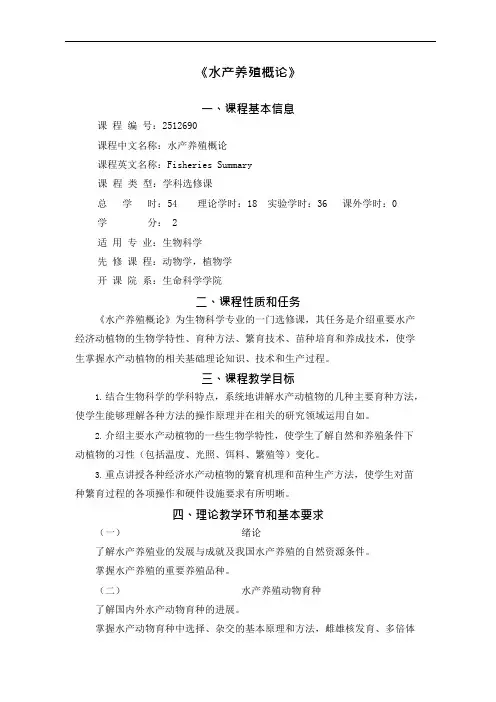
《水产养殖概论》一、课程基本信息课程编号:2512690课程中文名称:水产养殖概论课程英文名称:Fisheries Summary课程类型:学科选修课总学时:54 理论学时:18 实验学时:36 课外学时:0学分: 2适用专业:生物科学先修课程:动物学,植物学开课院系:生命科学学院二、课程性质和任务《水产养殖概论》为生物科学专业的一门选修课,其任务是介绍重要水产经济动植物的生物学特性、育种方法、繁育技术、苗种培育和养成技术,使学生掌握水产动植物的相关基础理论知识、技术和生产过程。
三、课程教学目标1.结合生物科学的学科特点,系统地讲解水产动植物的几种主要育种方法,使学生能够理解各种方法的操作原理并在相关的研究领域运用自如。
2.介绍主要水产动植物的一些生物学特性,使学生了解自然和养殖条件下动植物的习性(包括温度、光照、饵料、繁殖等)变化。
3.重点讲授各种经济水产动植物的繁育机理和苗种生产方法,使学生对苗种繁育过程的各项操作和硬件设施要求有所明晰。
四、理论教学环节和基本要求(一)绪论了解水产养殖业的发展与成就及我国水产养殖的自然资源条件。
掌握水产养殖的重要养殖品种。
(二)水产养殖动物育种了解国内外水产动物育种的进展。
掌握水产动物育种中选择、杂交的基本原理和方法,雌雄核发育、多倍体诱导、性别控制、细胞融合与核移植、转基因、种质资源保护的基本理论和应用技术。
(三)主要养殖鱼类的生物学与人工繁殖了解鱼类养殖的发展动态和政策法规。
掌握主要养殖鱼类的生物学、人工繁殖理论与技术、苗种培育和养成的理论和技术。
(四)经济甲壳类的繁殖与养殖了解虾蟹类增殖、活运、保鲜及加工的一般技术。
掌握甲壳动物的生物学特征,甲壳动物的分类知识。
另一方面重点掌握十足类经济虾蟹的基础生物学,虾蟹类育苗与养成的原理与通用技术,虾蟹类的增殖、活运与加工等技术。
(五)经济贝类的繁殖与养殖了解国内外贝类增养殖技术的发展趋势。
掌握养殖贝类的形态构造、生态习性,掌握贝类的苗种生产和增养殖方法。

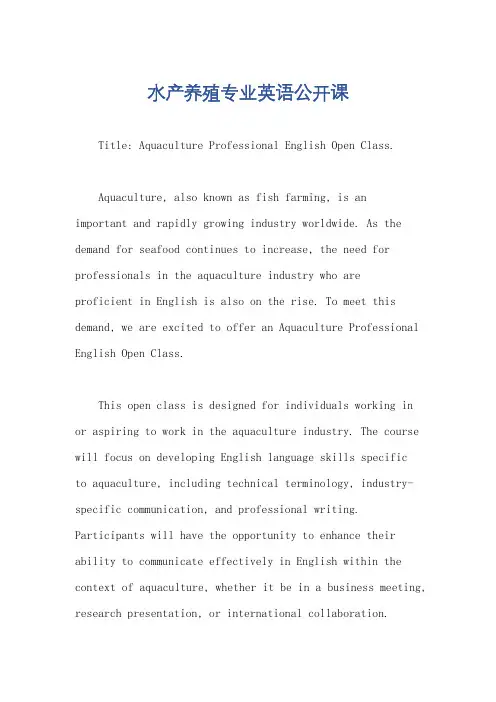
水产养殖专业英语公开课Title: Aquaculture Professional English Open Class.Aquaculture, also known as fish farming, is animportant and rapidly growing industry worldwide. As the demand for seafood continues to increase, the need for professionals in the aquaculture industry who areproficient in English is also on the rise. To meet this demand, we are excited to offer an Aquaculture Professional English Open Class.This open class is designed for individuals working inor aspiring to work in the aquaculture industry. The course will focus on developing English language skills specificto aquaculture, including technical terminology, industry-specific communication, and professional writing. Participants will have the opportunity to enhance their ability to communicate effectively in English within the context of aquaculture, whether it be in a business meeting, research presentation, or international collaboration.The Aquaculture Professional English Open Class will cover a range of topics, including:1. Aquaculture Industry Overview: Understanding the global aquaculture industry, its trends, and challenges.2. Technical Terminology: Learning and practicing industry-specific vocabulary related to fish farming, aquatic animal health, feed management, and more.3. Effective Communication: Developing skills for clear and professional communication in English, including email correspondence, phone conversations, and public speaking.4. Writing Skills: Improving written communication for reports, proposals, and scientific papers related to aquaculture.5. International Collaboration: Navigating cross-cultural communication and collaboration within the aquaculture industry.The open class will be led by experienced instructors with expertise in both English language instruction and aquaculture. Through a combination of lectures, interactive activities, and real-world simulations, participants will gain practical and applicable English language skills tailored to the aquaculture profession.Whether you are a fish farmer, aquaculture researcher, industry professional, or student, this open class is an opportunity to enhance your English language proficiency within the context of aquaculture. By improving yourEnglish communication skills, you can expand your career opportunities, engage in global networking, and contributeto the sustainable growth of the aquaculture industry.Join us for the Aquaculture Professional English Open Class and take your English language proficiency to thenext level in the exciting and dynamic field of aquaculture. We look forward to welcoming you and supporting your professional development in this important industry.。